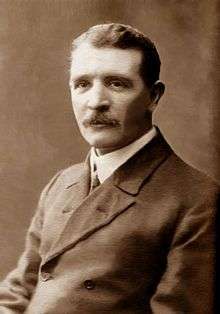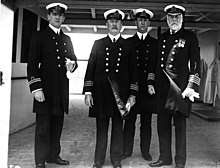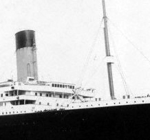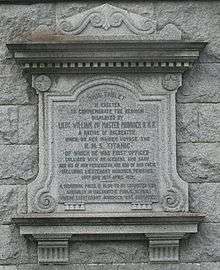William McMaster Murdoch
William McMaster Murdoch, RNR (28 February 1873 – 15 April 1912) was a Scottish sailor, who was the First Officer of the RMS Titanic. He was the officer in charge on the bridge when the Titanic collided with an iceberg in the North Atlantic Ocean. He was one of 1,502 people who died when the ship sank.[1] The circumstances of his death have been subject to controversy.
Lieutenant William McMaster Murdoch | |
|---|---|
 An undated photo of Murdoch, later published in accounts of the sinking of the Titanic. | |
| Born | 28 February 1873 |
| Died | 15 April 1912 (aged 39) Onboard RMS Titanic, North Atlantic Ocean |
| Other names | Will Murdoch |
| Education | Dalbeattie High School |
| Occupation | Ship's First Officer |
| Spouse(s) | Ada Banks ( m. 1907) |
| Notes | |
Life and career
Murdoch was born in Dalbeattie in Kirkcudbrightshire (now Dumfries and Galloway), Scotland, the fourth son of Captain Samuel Murdoch, a master mariner, and Jane Muirhead, six of whose children survived infancy. The Murdochs were a long and notable line of Scottish seafarers; his father and grandfather were both sea captains as were four of his grandfather's brothers.
Murdoch was educated first at the old Primary School in High Street, and then at the Dalbeattie High School in Alpine Street until he gained his diploma in 1887. Finishing schooling, he followed in the family seafaring tradition and was apprenticed for five years to William Joyce & Coy, Liverpool, but after four years (and four voyages) he was so competent that he passed his second mate's Certificate on his first attempt.
He served his apprenticeship aboard the Charles Cosworth of Liverpool, trading to the west coast of South America. From May 1895, he was First Mate on the St. Cuthbert, which sank in a hurricane off Uruguay in 1897. Murdoch gained his Extra Master's Certificate at Liverpool in 1896, at age 23. From 1897 to 1899, he was First Officer aboard the J. Joyce & Co. steel four-masted 2,534-ton barque Lydgate, that traded from New York to Shanghai.


An officer of the Royal Naval Reserve, he was employed by the White Star Line in 1900. From 1900 to 1912, Murdoch gradually progressed from Second Officer to First Officer and quickly rose to the rank of officer, serving on a successive number of White Star Line vessels, Medic (1900, along with Charles Lightoller, Titanic's second officer), Runic (1901–1903), Arabic (1903), Celtic (1904), Germanic (1904), Oceanic (1905), Cedric (1906), Adriatic (1907–1911) and Olympic (1911–1912).
In 1903, Murdoch met a 29-year-old New Zealand school teacher named Ada Florence Banks en route to England on either the Runic or the Medic. They began to correspond regularly and on 2 September 1907 they were wed in Southampton at St Denys Church. The marriage register entry was witnessed by Captain William James Hannah and his wife and the addresses given by the bride and groom suggest they were lodging with the Hannahs. Captain Hannah came from a family of seafarers with their roots in Kircudbrightshire like Murdoch, and was Assistant Marine Superintendent for the White Star Line at Southampton. Hannah would see Murdoch for the last time when he witnessed the testing of lifeboats before Titanic departed from Southampton on 10 April 1912.[2]
During 1903, Murdoch finally reached the stormy and glamorous North Atlantic run as Second Officer of the new liner Arabic. His cool head, quick thinking and professional judgement averted a disaster when a ship was spotted bearing down on the Arabic out of the darkness. He overrode a command from his superior, Officer Fox, to steer hard-a-port, rushing into the wheelhouse, brushing aside the quartermaster and holding the ship on course. The two ships passed within inches of one another. Any alteration in course would have actually caused a collision.
The final stage of Murdoch's career began in May 1911, when he joined the new RMS Olympic, at 45,000 long tons (46,000 t). Intended to outclass the Cunard ships in luxury and size, it needed the most experienced large-liner crew that the White Star Line could find. Captain Edward J. Smith assembled a crew that included Henry Wilde as Chief Officer, Murdoch as First Officer, and Chief Purser Herbert McElroy. On 14 June 1911 Olympic departed on her maiden voyage to New York, arriving there on the 21st.
The first indications of what was to come occurred on 20 September when the Olympic had her hull badly damaged in a collision with the Royal Navy cruiser HMS Hawke. Since Murdoch was at his docking-station at the stern during this collision – a highly responsible position – he found himself giving evidence in the inquiry into an incident that turned into a financial disaster for the White Star Line, as the voyage to New York had to be abandoned and the ship taken to Belfast for repairs, which took a good six weeks. It was thus not until 11 December 1911 that Murdoch rejoined the ship. During the time that he served aboard as First Officer (until some time in March, 1912) there were two further – though lesser – incidents, striking a sunken wreck and having to have a broken propeller replaced, and nearly running aground while leaving Belfast. However, upon reaching Southampton, he learned that he had been appointed as Chief Officer of the new Titanic, the Olympic's sister ship and reputedly the largest and most luxurious one afloat. Lightoller later remarked that "three very contented chaps" headed north to Belfast, for he had been appointed First Officer, and their friend Davy Blair was to be the new second officer. Awaiting them would be an old Adriatic hand, Joseph Groves Boxhall, as Fourth Officer, and others who would be familiar colleagues, including the now aging Edward J. Smith as Captain and on the verge of retirement.
Titanic
Murdoch, with an "ordinary master's certificate" and a reputation as a "canny and dependable man", had climbed through the ranks of the White Star Line to become one of its foremost senior officers. Murdoch was originally selected as the Chief Officer for Titanic's maiden voyage. However, the captain, Edward J. Smith, brought Henry Wilde in as his Chief Officer (from a prior assignment), so Murdoch became the First Officer. Charles Lightoller was in turn reduced to Second Officer, and the original Second, David Blair, would not sail with Titanic at all.

At approximately 11:39 pm on 14 April 1912, First Officer Murdoch was in charge when a large iceberg directly in the Titanic's path was sighted. Quartermaster Robert Hichens, who was at the helm, and Fourth Officer Joseph Boxhall, who may or may not have been on the bridge during the collision,[3] both stated that Murdoch gave the order "Hard-a-starboard",[4][5][6] a tiller command which would turn the ship to port (left) by moving the tiller to starboard (right).
At the time steering instructions on British ships generally followed the way tillers on sailing vessels are operated, with turns in the opposite direction from the commands. As Walter Lord noted in The Night Lives On, this did not fully change to the "steering wheel" system of commands in the same directions as turns until 1924. It has been alleged that Murdoch's orders were misinterpreted by the helmsman, resulting in a turn the wrong way.[7]
Fourth Officer Boxhall testified that Murdoch set the ship's telegraph to "Full Astern", but Greaser Frederick Scott and Leading Stoker Frederick Barrett testified that the stoking indicators went from "Full" to "Stop".[8] During or right before the collision he may have also given an order (as heard by Quartermaster Alfred Olliver when he walked onto the bridge in the middle of the collision) of "Hard a'port"[9] (moving the tiller all the way to the port (left) side turning the ship to starboard (right)) in what may have been an attempt to swing the remainder (aft section) away from the berg in a common manoeuvre called a "port around"[10] (this could explain his comment to the captain "I intended to port around it"). The fact that such a manoeuvre was executed was supported by other crew members who testified that the stern of the ship never hit the iceberg.[11] The orders that Murdoch gave to avoid the iceberg are debated. According to Oliver, Murdoch ordered the helm "hard to port" to ward off the stern of the iceberg. Hichens and Boxhall made no mention of the order. However, since the stern avoided the iceberg, it is likely that the order was given and carried out.[12][13]
Despite these efforts, the ship made its fatal collision about 37 seconds[14] after the iceberg had been sighted, opening the first five compartments (the forward peak tank, the three forward holds and Boiler Room 6) to the sea.[15] After the collision, Murdoch was put in charge of the starboard evacuation during which he launched ten lifeboats. Murdoch perished in the sinking and his body was never recovered.[16]
Death
On the rescue ship Carpathia, coming into New York Harbor, rumors were circulating from a number of survivors that a shooting incident had happened in the last minutes of the sinking.[17] At least two passengers, Third Class Passenger Eugene Daly and First Class passenger George Rheims, claimed to have seen an officer shoot one or two men and commit suicide by shooting himself.[18] It became widely rumored that Murdoch was that officer.
Second Officer Lightoller refuted the rumors. In a letter to Murdoch's widow, he claimed that he saw Murdoch working to free Collapsible A and was swept into the sea by the wave washing over the boat deck and that "other reports as to the ending are absolutely false".[19][20] However, Lightoller's testimony at the U.S inquiry suggests that he was not in a position to witness Murdoch being swept into the sea. It is also possible that Lightoller may have wanted to conceal the suicide, if it occurred, from Murdoch's widow. Later in life, Lightoller, according to a family friend, is said to have admitted that someone he knew did die by suicide that night. In a letter to a Titanic researcher, James O. McGiffin, son of Captain James McGiffin, who was a close personal friend to Murdoch, and served with both Murdoch and Lightoller, said that Lightoller had told his father that Murdoch had shot a man.[19][20]
The alleged incident of an officer's suicide was portrayed in the 1996 miniseries Titanic, and James Cameron's 1997 film Titanic, both presenting Murdoch as the suicide victim.[17] When Murdoch's nephew Scott saw the film, he objected to his uncle's portrayal as damaging to Murdoch's heroic reputation,[21] and film executives later flew to Murdoch's hometown to apologize.[22] The film's director, James Cameron, said that the depiction wasn't meant to be negative, and added, "I'm not sure you'd find that same sense of responsibility and total devotion to duty today. This guy had half of his lifeboats launched before his counterpart on the port side had even launched one. That says something about character and heroism."[23][24]
Legacy
Shortly after the sinking of the Titanic, the New York Herald published a story about Rigel, a dog reportedly owned by Murdoch who saved some of the survivors from the sinking.[25] While the story was widely reproduced, contemporary analyses cast doubt on whether the dog actually existed.[26]

In Murdoch's hometown of Dalbeattie, Dumfries and Galloway, Scotland, a memorial was created. In 1997, James Cameron donated money to establish a charitable prize in Murdoch's name.
In April 2012, Premier Exhibitions announced that it had identified Murdoch's belongings from a prior expedition to the wreck of the Titanic in 2000. There was a toiletry kit, a spare White Star Line officer's button, a straight razor, a shoe brush, a smoking pipe, and a pair of long johns.[27] The items were recovered by David Concannon, Ralph White and Anatoly Sagalevitch diving in the Russian submersible Mir 1 in July 2000.
Portrayals
- Theo Shall (1943) (Titanic)
- Barry Bernard (1953) (Titanic)
- Richard Leech (1958) (A Night to Remember)
- Paul Young (1979) (S.O.S. Titanic) (TV Movie)
- Stan Bocko (1989) (Pilots of the Purple Twilight) (A play by Steve Kluger)
- Malcolm Stewart (1996) (Titanic) (TV Miniseries)
- David Costabile (1997) (Titanic) (Broadway Musical)
- Ewan Stewart (1997) (Titanic)
- Courtenay Pace (1998) (Titanic: Secrets Revealed) (TV Documentary)
- Charlie Arneson (2003) (Ghosts of the Abyss) (Documentary)
- Brian McCardie (2012) (Titanic) (TV series/4 episodes)
- David McArdle (2016) (Pilots of the Purple Twilight) (A play by Steve Kluger)
References
- Walter Lord (1955), A Night To Remember, Penguin Books
- "Titanic and Transport Memorabilia Sale on Saturday 20th April 2013. Lot 212". henry-aldridge.co.uk.
R.M.S. TITANIC: CAPTAIN MAURICE CLARKE ARCHIVE. Typed notes dated April 28th 1912 relating to the Board of Trade enquiry into Titanic. The notes detail Captain Clarke's inspection into the lifeboats. "On the morning of sailing Wed 10th April, I gave instructions to the Chief Officer after The Board of Trade muster, to swing out No's 4 and 15 lifeboats which were situated on the starboard side of boat deck. The two boats were swung out one at a time. The time occupied the covers and grips on being 3¼ and 3½ minutes this being checked by Captains Steel and Hannah, the two marine Superintendents. All worked most satisfactorily, the crews were exercised by their officers and were fully satisfied as to the crew's efficiency."
- "Appendix II: STOP Command / "Porting Around" Maneuver". marconigraph.com. Retrieved 23 August 2016.
Fourth Officer Joseph Boxhall reported during the Enquiry that upon arriving on the bridge after the fact, he saw both telegraph handles pointing to FULL ASTERN, and heard Murdoch report that the engines had been reversed to Captain Smith. This, in effect, has led historians to believe that Murdoch rang down a 'crash stop.'
- Nathan Robison (12 February 2002). "Hard a-starboard". Encyclopedia Titanica.
- "Titanic Inquiry Project – United States Senate Inquiry". titanicinquiry.org.
- "Testimony of Robert Hichens (Quartermaster, SS Titanic)". Titanic Inquiry Project - United States Senate Inquiry.
- Alleyne, Richard. "Titanic sunk by steering blunder, new book claims". Telegraph.co.uk. Retrieved 27 June 2018.
- "STOP Command / "Porting Around" Maneuver". marconigraph.com.
- "STOP Command / "Porting Around" Maneuver". marconigraph.com.
- ""Last Log of the Titanic" -Four Revisionist Theories – a "port around" or S-curve manoeuvre in which "the bow is first turned away from the object, then the helm is shifted (turned the other way) to clear the stern"". Archived from the original on 28 October 2003. Retrieved 12 March 2009.
- "STOP Command / "Porting Around" Maneuver". marconigraph.com.
SENATOR BURTON: Do you not think that if the helm had been hard astarboard the bow would have been up against the berg? QUARTERMASTER GEORGE ROWE: It stands to reason it would, sir, if the helm were hard astarboard.
- (Mark Chirnside 2004, p. 155)
- (Gérard Piouffre 2009, p. 140)
- "titanic-model.com, '''Titanic and the Iceberg''' – By Roy Mengot". Titanic-model.com. 14 April 1912. Archived from the original on 20 September 2013. Retrieved 19 September 2013.
- "The whole impact had lasted only 10 seconds". Pbs.org. 10 April 1912. Retrieved 19 September 2013.
- Winocour 1960, p. 316.
- On A Sea of Glass: The Life & Loss of the R.M.S. Titanic (Tad Fitch, J. Kent Layton and Bill Wormstedt), Appendix K: "Shots in the Dark: Did an Officer Commit Suicide on the Titanic?", ISBN 1848689276), pg. 305.
- On A Sea of Glass: The Life & Loss of the R.M.S. Titanic (Tad Fitch, J. Kent Layton and Bill Wormstedt), Appendix A: "Titanic's Technical Specifications & Some Common Technical Misconceptions", ISBN 1848689276), pgs. 305-308.
- "Charles Herbert Lightoller- William Murdoch".
- 101 Things You Thought You Knew About the Titanic - But Didn't! at Google Books.co.uk
- "Nephew angered by tarnishing of Titanic hero". BBC News. 24 January 1998. Retrieved 19 September 2013.
- "Titanic makers say sorry". BBC News. 15 April 1998.
- James Cameron’s Titanic, p. 129.
- "Murdoch". williammurdoch.net. Retrieved 23 August 2016.
- "Did Murdoch Have a Heroic Dog Named 'Rigel'?". williammurdoch.net. Retrieved 28 March 2018.
- Maltin & Aston 2011, p. 176.
- Prengaman, Peter (3 April 2012). "AP Exclusive: Titanic artifacts linked to officer". The San Diego Union-Tribune. Retrieved 24 May 2018.
- William McMaster Murdoch, A Career at Sea. By Susanne Störmer
- Encyclopedia Titanica
- Dalbeattie museum
Bibliography
- Bruce Beveridge (2009). Titanic, the ship magnificent. Volume two: interior design & fitting out. The History Press. p. 509. ISBN 9780752446264.
- Daniel Allen Butler (2009). The other side of the night: The Carpathia, the Californian and the night the Titanic was lost. Casemate Publishers. p. 254. ISBN 1935149024.
- Mark Chirnside (2004). The Olympic-class ships : Olympic, Titanic, Britannic. Tempus. p. 349. ISBN 0-7524-2868-3.
- Maltin, Tim; Aston, Eloise (29 November 2011). 101 Things You Thought You Knew About the Titanic . . . but Didn't!. Penguin. ISBN 978-1-101-55893-5. Retrieved 28 January 2013.
- Gérard Piouffre (2009). Le " Titanic " ne répond plus (in French). Larousse. p. 317. ISBN 9782035841964.
External links
- Dalbeattie Town History – Murdoch of the 'Titanic'
- Murdoch -The Man, the Mystery
- William McMaster Murdoch at Find a Grave
- William McMaster Murdoch: Women and Children First Order